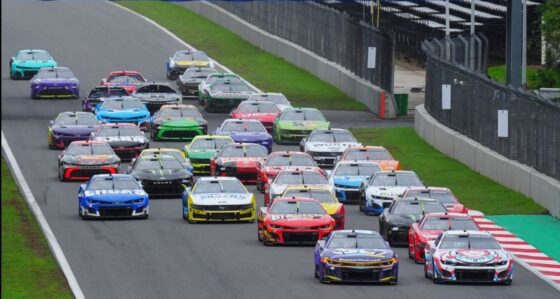“We have arrived at a format that makes every race matter even more, diminishes points racing, puts a premium on winning races and concludes with a best-of-the-best, first-to-the-finish line showdown race – all of which is exactly what fans want,” said Brian France, NASCAR Chairman and CEO, when he announced the original NASCAR playoffs format way back in 2014.
It sounded bold. It sounded perfect. And for a while, it even felt like the right direction. But fast forward to today’s data-heavy, parity-packed Cup garage, and not everyone’s buying into the hype anymore. Especially not one of NASCAR’s OGs, Mark Martin. Because while strategy has sharpened, competition has closed up, something has quietly gotten lost. Something bigger than points, faster than analytics, and deeper than any tire strategy.
Mark Martin compares the evolution of strategy and condemns the playoff system
Mark Martin has always been a straight-shooter when assessing NASCAR’s evolution. But his recent comments cut particularly deep into the heart of racing’s modern paradox. Speaking candidly on the Door Bumper Clear podcast, Martin observed, “There’s a lot more strategy now.” He then went on to compare the current scenario with his times.“When I raced, there were two or three guys that maybe would do something strategic, but your main thing, your main strategy was to have the fastest car,” he further added. This shift, thanks to the NASCAR playoff system, he believes, is both a blessing and a curse. Today’s Next Gen era has certainly amplified strategic depth and competitive closeness. The difference between the fastest car and 20th place has compressed drastically.
Martin highlights, “The 20th-place car is…let’s say he’s 3/10 off the top car. Well, when I was racing, the 20th-place car was 3/4 of a second off.” And he isn’t wrong. The Next-Gen car was designed to bring the racing field closer. NASCAR tried to achieve this by forcing teams to purchase parts for the car from the same source instead of developing themselves. And the result? Parity between the teams. “So you put the 20th-place car in front of the fastest car and he wasn’t going to last very long up there, even if you had aero, you know, stuff coming into play. But the real problem of passing today, even though we do have aero issues, is that the 20th-place car ain’t that slow and so it’s hard to pass,” he said further, explaining how even with aerodynamics, the cars behind are barely slower than the ones ahead.
However, Martin’s core disappointment centers on how the ‘win and you’re in’ NASCAR playoff structure often overshadows the meaning of a single race victory. “Somehow or another, making the playoffs has overshadowed the wins. Every single win was huge. And we’ve lost that somehow with this ‘win and you’re in’. The attention has shifted.” Take a look at the 2025 season, for example. It has produced 13 different winners, with just four of them managing more than one win. Teams look for that one win that can get them to the playoffs, and then shift focus entirely to survival mode. Once that golden ticket is punched, the goalposts move from outright speed to strategic conservation.
Even last year, Joey Logano won his third Cup championship by winning only one race in the regular season at Nashville. On the basis of it, he entered the playoffs and then methodically navigated each round without needing to dominate. His lone regular-season win was enough to qualify, and from there, consistent running in the NASCAR playoffs and a well-timed victory at Phoenix sealed the deal.
To be fair, NASCAR’s playoff overhaul has created intense, drama-filled finales and TV-friendly narratives. But as parity flattens the field and teams rely more on calculated gambles than sheer speed, Martin’s concern rings true: racing is shifting from guts to graphs. And that’s where the question lingers. Can NASCAR truly serve both the strategist and the speed demon without compromising the soul of the sport?
NASCAR considers playoff format changes for 2026
Mark Martin’s candid critique of the current ‘win and you’re in’ NASCAR playoff structure underscores a growing debate within the community. It is all about the true meaning of victory and weekly racing stakes. His perspective resonates not just with long-time drivers but also with fans and key stakeholders. In a sign that change could be on the horizon, NASCAR leadership has announced plans to reconsider the Cup Series playoff system ahead of the 2026 season.
According to NASCAR executive vice president and chief racing development officer John Probst, “We hear the fans loud and clear and are looking at it actively.” Probst revealed that throughout the current season, NASCAR will assemble a working group of media members, manufacturers, Goodyear, and drivers to “look at [the format] holistically” and assess where improvements could be made.
This marks the first significant review since the introduction of stage racing and NASCAR playoffs points in 2017, with the basic elimination structure. 16 drivers, four rounds, and a winner-takes-all finale, all of which remained unchanged since 2014. And now, one major change for 2026 has already been locked in.
NASCAR’s championship race will return to Homestead-Miami Speedway, kicking off a rotating finale format. But the road to that finale might look a little different, too. There’s talk of adding a 27th race to the regular season. If NASCAR keeps the same number of total events, this would shorten the playoffs to nine races. That adjustment would likely result in a three-race championship round ending at Homestead.
While nothing is final yet, NASCAR has several months to iron out the details before releasing the full 2026 schedule. Still, the idea of a 27-race regular season signals the sport’s willingness to evolve and address long-standing concerns. Combined with ongoing discussions about playoff restructuring, the Cup Series could be headed for its biggest competitive shake-up in over a decade.
The post Mark Martin Expresses Displeasure as NASCAR’s Greatness Falls Prey to Its Own System appeared first on EssentiallySports.
